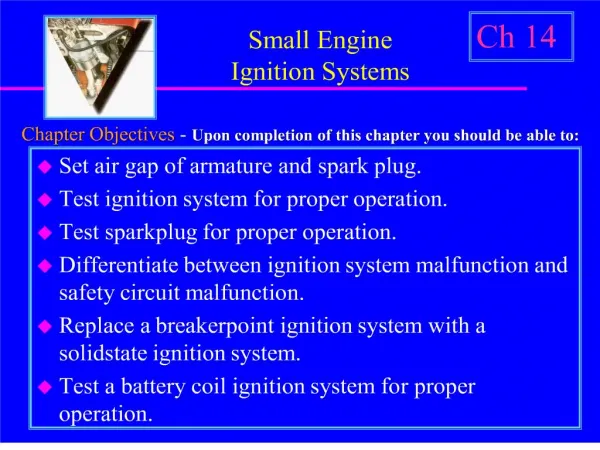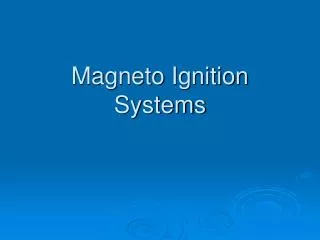IGNITION SYSTEMS
IGNITION SYSTEMS. Columbia Basin College. IGNITION FUNCTION. Produces 30,000 volt spark across spark plug Distributes high voltage spark to each spark plug in correct sequence Times the spark so it occurs as piston is nearing top dead center
Share Presentation
Embed Code
Link
Download Presentation

rwatanabe + Follow
Download Presentation
IGNITION SYSTEMS
An Image/Link below is provided (as is) to download presentation Download Policy: Content on the Website is provided to you AS IS for your information and personal use and may not be sold / licensed / shared on other websites without getting consent from its author. Content is provided to you AS IS for your information and personal use only. Download presentation by click this link. While downloading, if for some reason you are not able to download a presentation, the publisher may have deleted the file from their server. During download, if you can't get a presentation, the file might be deleted by the publisher.
Presentation Transcript
- IGNITION SYSTEMS Columbia Basin College
- IGNITION FUNCTION • Produces 30,000 volt spark across spark plug • Distributes high voltage spark to each spark plug in correct sequence • Times the spark so it occurs as piston is nearing top dead center • Varies spark timing with load, speed, and other conditions
- BASIC IGNITION SYSTEM COMPONENTS • BATTERY • IGNITION SWITCH • IGNITION COIL • SWITCHING DEVICE • SPARK PLUG • IGNITION SYSTEM WIRES
- BASIC IGNITION SYSTEM • Battery supplies power to entire system • Ignition Switch turns engine on or off • Coil transforms volts • Switching device triggers ignition coil • Spark Plug and wires distribute spark
- PRIMARY CIRCUIT • Consists of low voltage wiring and components • Uses conventional type automotive primary wires • Controls when ignition will take place. (When coil fires)
- SECONDARY CIRCUIT • Distributes current to individual cylinders to jump spark plug gap • Must have thicker, heavier insulation on wires • Typical voltage to jump gap - 10K Volts
- IGNITION COIL • TRANSFORMER • 2 SETS OF WINDINGS • Primary windings • Secondary windings • IRON CORE • PRODUCES MAGNETIC FIELD
- IGNITION SYSTEM TYPES • CONTACT POINT IGNITION SYSTEM • ELECTRONIC IGNITION SYSTEM • DISTRIBUTORLESS IGNITION SYSTEM
- CONTACT POINT SYSTEM • Distributor turns 1/2 engine rpm • Distributor Cam • Contact Points • Condenser • Point Dwell (Cam angle) • Basis for all Systems
- DWELL (CAM ANGLE) • Amount of time in distributor degrees that points remain closed between each opening • Coil saturation time is controlled by amount of dwell
- ELECTRONIC IGNITION SYSTEM • Uses electronic control circuit to operate the ignition coil • More dependable than contact system • Higher secondary Ignition voltages
- MAGNETIC PICK UP COIL • Produces tiny voltage pulses to create magnetic field changes • Trigger Wheel interrupts magnetic field • Tell control unit (amplifier) when to fire ignition coil
- HALL EFFECT DEVICE • Hall Effect element is a solid state device • Contains a permanent magnet next to element • A Tab shunts magnetic field to send signal to control unit • Signal is On or Off
- IGNITION CONTROL UNIT AMPLIFIER • Controls Primary current to tell Ignition Coil when to fire spark plugs
- HIGH VOLTAGE SECONDARY COMPONENTS • IGNITION COIL • COIL WIRE • DISTRIBUTOR • DISTRIBUTOR CAP • DISTRIBUTOR ROTOR • SPARK PLUG WIRE • SPARK PLUG
- SECONDARY CIRCUIT • DISTRIBUTES SPARK TO RIGHT PLACE AT RIGHT TIME • PARTS ARE DESIGNED TO CONTROL HIGH VOLTAGES
- SPARK PLUGS Pg 121C
- 1 1.Normal 2.Overheated 3.Pre-ignition 4.Cracked insulator 5.Bridged gap 6.Deposit fouled 7.Carbon glazed 8.Splashed 9.Glazed 10. Oil fouled 2 3 4 5 6 7 8 9 10
- SPARK PLUG TYPES
- DISTRIBUTORLESS IGNITION • Timing is very precise • No mechanical parts to wear out • Requires less maintenance • Ignition timing is USUALLY not adjustable • Computer relies on ignition sensors • On-board computer controls ignition timing usually through a ignition module
- DISTRIBUTORLESS IGNITION SYSTEM
- DIS System
- THE END

Small Engine Ignition Systems
Small Engine Ignition Systems. Ch 14. 14-2,14.-3 14.-4 14-10. Small Engine Ignition Systems. Ch 14. Armature air gap. Small Engine Ignition Systems. Ch 14. Ignition Timming. 4-18. Small Engine Ignition Systems. Ch 14. Photo of spark tester and Testing spark plug for proper operation. Small Engine Ignition Systems.
1.38k views • 10 slides

Magneto Ignition Systems
Magneto Ignition Systems. Table of Contents. I. Introduction to Magneto Ignition Systems What are Magneto Ignition Systems? What are the different uses for the Systems? II. Different Types of Systems MBI CDI TCI III. Summary IV. Review Questions. What are Magneto Ignition Systems?.
5.96k views • 20 slides




